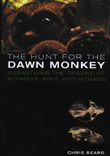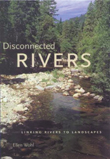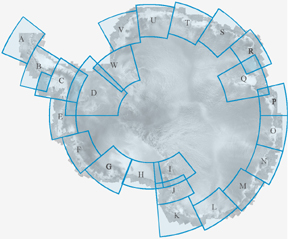 The
Hunt for the Dawn Monkey
The
Hunt for the Dawn Monkey
by Chris Beard.
University of California Press, 2004.
ISBN 0 5202 3369 7.
Hardcover, $27.50.

Check out this month's On the Web links, your connection to earth science friendly Web sites. The popular Geomedia feature is now available by topic.
Q&A:
Straight from the Source: Q&A with author Sean B. Carroll
Print exclusive
Books:
Deep roots: A review of The Hunt for the Dawn Monkey
Whither our rivers?: A review of Disconnected Rivers
Maps:
Antarctic coastal change and glaciology
 The
Hunt for the Dawn Monkey The
Hunt for the Dawn Monkey
by Chris Beard. |
The branches of the “Tree of Life” connect us to all living organisms
and to all organisms that have ever lived. The extinct organisms on the shortest
route through the Tree of Life between modern humans and the root of the tree
are our ancestors; those on nearby branches are our cousins. The longest version
of human evolution would be a journey that starts approximately 3 billion years
ago with the simplest form of life at the base of the tree. It would take more
than 2 billion years to pass up the trunk and along the major branches before
we enter the relatively small part of the tree that contains all animals. Then
we would enter the branch containing all the animals with backbones, then into
the mammal branch, and then into a thin branch that contains one of the subgroups
of mammals called the primates. At the base of this primate branch, we are still
at least 60 million years away from the present day.
The last leg of the human evolutionary journey would take us into the monkey
and ape branch of the Tree of Life, and then into the great ape branch. Sometime
between 15 million and 12 million years ago, we would move into the small branch
that gave rise to contemporary modern humans and to the living African apes.
Between 12 million and 9 million years ago, the branch for the gorillas split
off to leave just a single slender branch consisting of the ancestors of chimpanzees
and modern humans. Researchers estimate that between 12 million and 5 million
years, this very small branch split into two twigs. Both twigs end on the surface
of the Tree of Life. One has the modern-day chimpanzees at the end of it; the
other, modern humans.
Most books about human evolution deal only with the branch of paleontology called
palaeoanthropology, which is the science that tries to reconstruct the evolutionary
history of the small, exclusively human twig of the Tree of Life. But Chris
Beard is a primate paleontologist, not a paleoanthropologist, and his research
interest is recovering the evolutionary history of the branch that includes
the monkeys and apes, collectively called anthropoids. Thus, Beard’s book
The Hunt for the Dawn Monkey tells the story of his own fossil discoveries,
and the way in which they, and his interpretations of them, have turned traditional
hypotheses about anthropoid origins on their head. The book also carries important
messages for those of us who concentrate on reconstructing human evolutionary
history.
The basic classification of living primates we use today was proposed by Reginald
Pocock in 1918. It was based on morphology, but it is consistent with the latest
molecular evidence. It divides the primates into two groups. One, consisting
of the lemurs, lorises and bush babies, is called the Strepsirhini because they
have “twisted” noses. The other, consisting of the tarsiers and the
anthropoids, is called the Haplorhini because they have “flat” noses.
Conventional wisdom suggests that the living strepsirhines are more primitive
than the living haplorhines. Because of this, many scientists assumed that the
earliest fossil primates would be strepsirhine-like, and that only in the later
stages of primate evolution would there be evidence of anthropoid-like fossil
primates. Because the earliest anthropoids were from sites in Africa (in Algeria
and from classic localities in the Fayum region of Egypt), it was assumed that
anthropoids originated in Africa.
Beard used similar logic, but different evidence, to come up with a very different
hypothesis about anthropoid origins. He concluded that the two major groups
of haplorhine primates were more closely related to each other than either was
to the strepsirhines. And if the only surviving tarsiers were confined to Asia,
then logically the common ancestor of tarsiers and anthropoids, and probably
the most primitive anthropoids also, should be Asian creatures. This logic is
the same as that used by Charles Darwin when he suggested that modern humans
most likely evolved in Africa because our closest living relatives, chimpanzees
and gorillas, were confined to Africa.
The book takes the reader through the long chain of events, some of them serendipitous,
others the result of a considerable intellect interpreting clues that others
were ignoring or misinterpreting. This chain took Beard to sites as far apart
as Wyoming and China where he made his influential discoveries. The title is
a play on words, referring to the Dawn Man theory, developed by Henry Fairfield
Osborn in the early 20th century, which held that modern humans were not closely
related to the monkeys and apes, but instead were derived from an ancient ancestor.
I have to confess that in the past when I traced higher primate evolution back
much beyond the Miocene, my attention would begin to wander. But Beard had me
well and truly hooked. He manages to transmit his own intellectual enthusiasm
for a part of the Tree of Life that consists of small shrew-like animals. He
is helped substantially by his artist Mark Klingler, whose line drawings are
part exquisite naturalistic reconstructions and part explanatory cartoons.
To cut an exceptionally well-told story short, Beard suggests that primates
and the rest of the mammal subgroup called the Archonta represent just “one
twig on what appears to be an exclusively Asian branch of the mammalian family
tree.” He makes the point that apart from the odd assortment of animals
that did originate in Africa — the Afrotheres — all the other modern
mammals that are relatively abundant in Africa today (antelopes, carnivores,
etc.) are immigrants (see Geotimes, June 2005).
The debates about the origins of anthropoids and the origins of hominins have
much in common. In both cases, researchers disagree about the pattern of evolution
and about the role factors such as climate play in shaping macroevolutionary
events.
Beard and his editors are to be congratulated. This book is well-written, and
it is remarkably error-free. Unfortunately, these are rare attributes, but all
the more reason to comment on them. Anyone interested in the history of the
science of where we evolved from will appreciate and learn from The Hunt
for the Dawn Monkey.
 Disconnected
Rivers: Linking Rivers to Landscapes Disconnected
Rivers: Linking Rivers to Landscapes by Ellen Wohl. Yale University Press, 2004. ISBN 0 3001 0332 8. Hardcover, $35.00. |
Ellen Wohl is one of the few front-line earth scientists with a knack for writing
in the environmentalist vein pioneered by John Muir, Aldo Leopold and Rachel
Carson. In Disconnected Rivers, she explores the history of how people
transformed rivers during the expansion of European American settlement and
the economic development of North America.
The title plays on the geomorphological adage that rivers are the circulatory
system of their watersheds. In geologic terms, everything we produce, erode
or leave around the landscape eventually makes its way down a river (or up into
the air). Wohl intersperses personal anecdotes and engaging detours with summaries
of technical studies as she creates a detailed portrait of historic changes
to river systems across the country. She shows how thinking about rivers in
isolation from their watersheds has disconnected waterways from their floodplains
and impoverished a foundational element of our natural heritage.
Put simply, this book needed to be written; even disturbed rivers can be beautiful,
and most people have little appreciation for how much America’s rivers
have changed over the past several centuries. Wohl addresses the effects of
mining (the best and most comprehensive treatment of the subject that I’ve
read), the role of industrial poisoning of rivers (including the famous burning
Cuyahoga River in Cleveland), and the 20th century drive of federal institutions
to dam rivers for power, flood control, irrigation and water supplies. The book
also reviews recent restoration efforts aimed at undoing (or mitigating) the
human impacts on rivers that she describes throughout the volume. Although at
times a bit too technical for a wide audience, Disconnected Rivers is
richly illustrated and full of great examples.
One of the big challenges of the new era of river restoration lies in how concepts
and methods developed in one region are mindlessly exported to other regions.
Most geomorphologists tend to work in a particular region, and Wohl provides
a broad perspective by adopting a national focus and laying out regional differences
between rivers in various parts of the country. Making this book required reading
for students embarking on careers in river restoration would help them develop
the intellectual context needed to understand the rivers and streams they end
up working on wherever they practice their art.
Wohl ends by issuing a national rallying cry to respect and conserve rivers,
citing Taoist philosopher Lao Tzu as well as her own desire to see American
rivers restored to functional, connected systems. After reading Disconnected
Rivers, I am reminded that although we are already some way into the century
of environmental restoration, we still have a lot of work to do.
 Coastal
ice, in its various forms, makes Antarctica home to the most dynamic coastlines
in the world. Changes in climate directly affect the volume of coastal ice in
Antarctica, and the volume of water trapped in Antarctic ice is capable, if
released, of significantly raising sea level worldwide. These far-reaching effects
make documenting and understanding changes in coastal Antarctica of the utmost
importance. The U.S. Geological Survey (USGS) Coastal Change and Glaciological
Maps of Antarctica Project is documenting that change and making an inventory
of glaciers in a series of 23 1:1,000,000-scale maps and a single comprehensive
1:5,000,000-scale map, covering the entire coastline of the continent.
Coastal
ice, in its various forms, makes Antarctica home to the most dynamic coastlines
in the world. Changes in climate directly affect the volume of coastal ice in
Antarctica, and the volume of water trapped in Antarctic ice is capable, if
released, of significantly raising sea level worldwide. These far-reaching effects
make documenting and understanding changes in coastal Antarctica of the utmost
importance. The U.S. Geological Survey (USGS) Coastal Change and Glaciological
Maps of Antarctica Project is documenting that change and making an inventory
of glaciers in a series of 23 1:1,000,000-scale maps and a single comprehensive
1:5,000,000-scale map, covering the entire coastline of the continent.
New maps of Antarctica evidence the rapidly
changing coastlines of the continent. Letters here correspond to 23 areas, charted
individually in 1:1,000,000-scale maps. Courtesy of Kevin M. Foley.
The primary source of data used in compiling the maps is the 30-plus-year record
of coastal Antarctica generated by Landsat. The Landsat satellites provide geographic
coverage poleward to approximately 81.5 degrees south latitude, which proves
sufficient for most coastal areas.
The Coastal Change and Glaciological Maps of Antarctica are produced in cooperation
with other Antarctic mapping groups, including scientists from Italy, Russia,
Norway, Canada, Australia, Argentina and Germany. USGS produced the three maps
covering the Antarctic Peninsula in close cooperation with the British Antarctic
Survey, and the Bundesamt für Kartographie und Geodäsie provided a
tightly ground-controlled mosaic of Landsat images for use as a base for mapping.
The RAMP AMM-1 SAR image mosaic of Antarctica is the mapping base for the remaining
20 maps, and along with MODIS imagery, charts features that are south of the
geographic limit of Landsat. Other data sources include aerial photography,
maps, field surveys and logs, some dating back to the 1800s.
 |
Geotimes Home | AGI Home | Information Services | Geoscience Education | Public Policy | Programs | Publications | Careers |